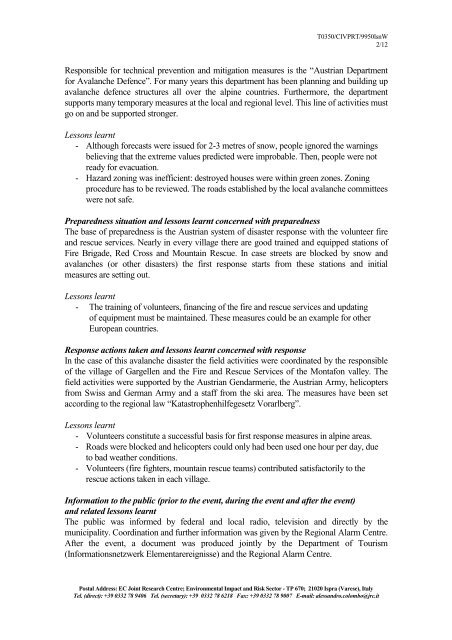lessons learnt from avalanche disasters - PreventionWeb
lessons learnt from avalanche disasters - PreventionWeb
lessons learnt from avalanche disasters - PreventionWeb
Create successful ePaper yourself
Turn your PDF publications into a flip-book with our unique Google optimized e-Paper software.
T0350/CIVPRT/9950lsnW<br />
2/12<br />
Responsible for technical prevention and mitigation measures is the “Austrian Department<br />
for Avalanche Defence”. For many years this department has been planning and building up<br />
<strong>avalanche</strong> defence structures all over the alpine countries. Furthermore, the department<br />
supports many temporary measures at the local and regional level. This line of activities must<br />
go on and be supported stronger.<br />
Lessons <strong>learnt</strong><br />
- Although forecasts were issued for 2-3 metres of snow, people ignored the warnings<br />
believing that the extreme values predicted were improbable. Then, people were not<br />
ready for evacuation.<br />
- Hazard zoning was inefficient: destroyed houses were within green zones. Zoning<br />
procedure has to be reviewed. The roads established by the local <strong>avalanche</strong> committees<br />
were not safe.<br />
Preparedness situation and <strong>lessons</strong> <strong>learnt</strong> concerned with preparedness<br />
The base of preparedness is the Austrian system of disaster response with the volunteer fire<br />
and rescue services. Nearly in every village there are good trained and equipped stations of<br />
Fire Brigade, Red Cross and Mountain Rescue. In case streets are blocked by snow and<br />
<strong>avalanche</strong>s (or other <strong>disasters</strong>) the first response starts <strong>from</strong> these stations and initial<br />
measures are setting out.<br />
Lessons <strong>learnt</strong><br />
- The training of volunteers, financing of the fire and rescue services and updating<br />
of equipment must be maintained. These measures could be an example for other<br />
European countries.<br />
Response actions taken and <strong>lessons</strong> <strong>learnt</strong> concerned with response<br />
In the case of this <strong>avalanche</strong> disaster the field activities were coordinated by the responsible<br />
of the village of Gargellen and the Fire and Rescue Services of the Montafon valley. The<br />
field activities were supported by the Austrian Gendarmerie, the Austrian Army, helicopters<br />
<strong>from</strong> Swiss and German Army and a staff <strong>from</strong> the ski area. The measures have been set<br />
according to the regional law “Katastrophenhilfegesetz Vorarlberg”.<br />
Lessons <strong>learnt</strong><br />
- Volunteers constitute a successful basis for first response measures in alpine areas.<br />
- Roads were blocked and helicopters could only had been used one hour per day, due<br />
to bad weather conditions.<br />
- Volunteers (fire fighters, mountain rescue teams) contributed satisfactorily to the<br />
rescue actions taken in each village.<br />
Information to the public (prior to the event, during the event and after the event)<br />
and related <strong>lessons</strong> <strong>learnt</strong><br />
The public was informed by federal and local radio, television and directly by the<br />
municipality. Coordination and further information was given by the Regional Alarm Centre.<br />
After the event, a document was produced jointly by the Department of Tourism<br />
(Informationsnetzwerk Elementarereignisse) and the Regional Alarm Centre.<br />
Postal Address: EC Joint Research Centre; Environmental Impact and Risk Sector - TP 670; 21020 Ispra (Varese), Italy<br />
Tel. (direct): +39 0332 78 9406 Tel. (secretary): +39 0332 78 6218 Fax: +39 0332 78 9007 E-mail: alessandro.colombo@jrc.it












![View full document [PDF 988.55 KB] - PreventionWeb](https://img.yumpu.com/47733942/1/184x260/view-full-document-pdf-98855-kb-preventionweb.jpg?quality=85)
![View full document (in French) [PDF 4.96 MB] - PreventionWeb](https://img.yumpu.com/47223870/1/184x260/view-full-document-in-french-pdf-496-mb-preventionweb.jpg?quality=85)


![View full document [PDF 25.02 MB] - PreventionWeb](https://img.yumpu.com/44204570/1/190x234/view-full-document-pdf-2502-mb-preventionweb.jpg?quality=85)
